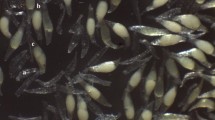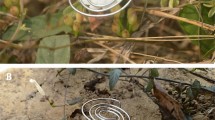Abstract
Low capsule and seed set is a major factor limiting seed production in Eucalyptus globulus seed orchards. Controlled pollination studies showed that the reproductive success (number of seeds produced per flower pollinated) was primarily determined by the female. We aimed to identify the factors contributing to the differences in reproductive success between female genotypes in terms of the physical and anatomical properties of the flower. We studied pairs of genotypes of high and low reproductive success from each of three races (Furneaux Group, Strzelecki Ranges and Western Otways) growing in a seed orchard. Controlled pollinations were performed on six females and along with flower physical measurements, pollen tube growth and seed set were assessed. Overall tree reproductive success was positively correlated with flower size, ovule numbers, style size, cross-sectional area of conductive tissue within the style (all of which were inter-correlated) and the proportion of pollen tubes reaching the bottom of the style. Significant positive correlations of reproductive success and flower physical properties between different ramets of the same genotypes across seasons suggests a genetic basis to the variation observed. The majority of pollen tube attrition occurred within the first millimetre of the cut style and appeared to be associated with differences in style physiology. When examined as pairs within races the difference in reproductive success for the Western Otways pair was simply explained by differences in flower size and the number of ovules per flower. Physical features did not differ significantly for the Strzelecki Ranges pair, but the proportion of pollen tubes reaching the bottom of the style was lower in the less reproductively successful genotype, suggesting an endogenous physiological constraint to pollen tube growth. The difference in reproductive success between the females from the Furneaux Group was associated with a combination of these factors.


Similar content being viewed by others
References
Bawa KS, Webb CJ (1984) Flower, fruit and seed abortion in tropical forest trees: implications for the evolution of paternal and maternal reproductive patterns. Am J Bot 71:736–751
Borralho NMG, Almeida IM, Cotterill PP (1992) Genetic control of growth of young Eucalyptus globulus clones in Portugal. Silvae Genet 41:100–105
Callister AN, Collins RJ (2007) Genetic selection reduces the cost of Eucalyptus globulus seed produced by mass supplementary pollination. In: Eucalyptus and diversity balancing productivity and sustainability, Durban, South Africa, p 54. (CD Rom)
Cruzan MB (1986) Pollen-tube distributions in Nicotiana glauca: evidence for density-dependent growth. Am J Bot 73:902–907
Cruzan MB (1993) Analysis of pollen-style interactions in Petunia hybrida: the determination of variance in male reproductive success. Sex Plant Reprod 6:275–281
de Graaf BHJ, Derksen JWM, Mariani C (2001) Pollen and pistil in the progamic phase. Sex Plant Reprod 14:41–55
Dutkowski GW, Potts BM (1999) Geographic patterns of genetic variation in Eucalyptus globulus ssp. globulus and a revised racial classification. Aust J Bot 47:237–263
Eldridge K, Davidson J, Harwood C, van Wyk G (1993) Eucalypt domestication and breeding. Clarendon Press, Oxford
Ellis MF, Sedgley M, Gardner JA (1991) Interspecific pollen pistil interaction in Eucalyptus (Myrtaceae): the effect of taxonomic distance. Ann Bot 68:185–194
Espejo J, Griffin AR (2001) Consideraciones operacionales en cruzamientos controlados masales (OSP) de Eucalyptus globulus Labill en cuartro temperadas. In ‘Developing the eucalypt of the future’, Valdivia, Chile (INFOR)
Gore PL, Potts BM (1995) The genetic control of flowering time in Eucalyptus globulus, E. nitens and their F1 hybrids. In: Potts BM, Borralho NMG, Reid JB, Cromer RN, Tibbits WN, Raymond CA (eds) Eucalypt plantations: improving fibre yield and quality (CRC for Temperate Hardwood Forestry), Hobart, Tasmania, pp 241–242
Gore PL, Potts BM, Volker PW, Megalos J (1990) Unilateral cross-incompatibility in Eucalyptus: the case of hybridisation between E. globulus and E. nitens. Aust J Bot 38:383–394
Griffin AR (2001) Deployment decision, capturing the benefits of tree improvement with clones and seedlings. In: Developing the eucalypt of the future, Valdivia, Chile, p 16. (IINFOR)
Harbard JL, Griffin AR, Espejo J (1999) Mass controlled pollination of Eucalyptus globulus: a practical reality. Can J For Res 29:1457–1463
Hardner CM, Potts BM (1995) Inbreeding depression and changes in variation after selfing in Eucalyptus globulus ssp. globulus. Silvae Genet 44:46–54
Herrero M (1992) From pollination to fertilization in fruit trees. Plant Growth Regul 11:27–32
Hiratsuka S, Zhang S (2002) Relationships between fruit set, pollen-tube growth, and S-RNase concentration in the self-incompatible Japanese pear. Sci Hortic 95:309–318
Hormaza JI, Herrero M (1996) Dynamics of pollen tube growth under different competition regimes. Sex Plant Reprod 9:153–160
Hormaza JI, Herrero M (1999) Pollen performance as affected by the pistilar genotype in sweet cherry (Prunus avium). Protoplasma 208:129–135
Jordan GJ, Potts BM, Kirkpatrick JB, Gardiner C (1993) Variation in the Eucalyptus globulus complex revisited. Aust J Bot 41:763–785
Lopez GA, Potts BM, Dutkowski GW, Traverso JMR (2001) Quantitative genetics of Eucalyptus globulus: affinities of land race and native stand localities. Silvae Genet 50:244–252
Lord EM (2003) Adhesion and guidance in compatible pollination. J Exp Bot 54:47–54
Marcelis LFM, Heuvelink E, Hofman-Eijer LRB, Den Bakker J, Xue LB (2004) Flower and fruit abortion in sweet pepper in relation to source and sink strength. J Exp Bot 55:2261–2268
Martin FM (1959) Staining and observing pollen tubes in the style by means of fluorescence. Stain Technol 34:125–128
McGowen MH, Potts BM, Vaillancourt RE, Gore P, Williams DR, Pilbeam DJ (2004a) The genetic control of sexual reproduction in Eucalyptus globulus. In: Borralho NMG, Pereira JS, Marques C, Coutinho J, Madeira M, Tomé M (eds) Eucalyptus in a changing world, Aveiro, Portugal (RAIZ, Instituto Investigação de Floresta e Papel), pp 104–108
McGowen MH, Potts BM, Vaillancourt RE, Gore PL, Williams DR (2004b) A genetic basis to the destruction of Eucalyptus globulus seed by wasps from the genus Megastigmus. In: Borralho NMG, Periera JS, Marques C, Coutinho J, Madeira M, Tomé M (Eds) ‘Eucalyptus in a Changing World’. Aveiro, Portugal. (RAIZ, Instituto Investigação de Floresta e Papel) pp. 187–188
Parsons M, Gavran M, Davidson J (2006) Australia’s plantations 2006. Australian Government: Department of Agriculture, Fisheries and Forestry, Canberra
Patterson B, Gore P, Potts BM, Vaillancourt RE (2004a) Advances in pollination techniques for large-scale seed production in Eucalyptus globulus. Aust J Bot 52:781–788
Patterson B, Vaillancourt RE, Pilbeam DJ, Potts BM (2004b) Factors affecting variation in outcrossing rate in Eucalyptus globulus. Aust J Bot 52:773–780
Pilbeam DJ, Dutkowski GW (2004) Simulation to determine optimal wood quality sampling strategies. In: Borralho NMG, Pereira JS, Marques C, Coutinho J, Madeira M, Tomé M (eds) Eucalyptus in a changing world, Aveiro, Portugal. (RAIZ, Instituto Investigação de Floresta e Papel) pp 211–212
Potts BM (2004) Genetic improvement of eucalypts. In: Evans J, Burley J, Youngquist J (eds) Encyclopaedia of forest science. Elsevier Science, Oxford, pp 1480–1490
Potts BM, Marsden-Smedley JB (1989) In vitro germination of Eucalyptus pollen: response to variation in boric acid and sucrose. Aust J Bot 37:429–441
Potts BM, McGowen MH, Williams DR, Suitor S, Jones TH, Gore PL, Vaillancourt RE (2008) Advances in reproductive biology and seed production systems of Eucalyptus: the case of Eucalyptus globulus. South Forests 70:145–154
Pound LM, Wallwork MAB, Potts BM, Sedgley M (2002) Self-incompatibility in Eucalyptus globulus ssp. globulus (Myrtaceae). Aust J Bot 50:365–372
Pound LM, Wallwork MAB, Potts BM, Sedgley M (2003) Pollen tube growth and early ovule development following self- and cross-pollination in Eucalyptus nitens. Sex Plant Reprod 16:59–69
Scribailo RW, Barrett SCH (1991) Pollen–pistil interactions in Tristylous pontederia sagittata (Pontederiaceae), patterns of pollen tube growth. Am J Bot 78:1662–1682
Sedgley M, Griffin AR (1989) Sexual reproduction of tree crops. Academic Press Limited, London
Stephenson AG (1981) Flower and fruit abortion: proximate causes and ultimate functions. Annu Rev Ecol Syst 12:253–279
Stephenson AG, Travers SE, Mena-Ali JI, Winsor JA (2003) Pollen performance before and during the autotrophic–heterotrophic transition of pollen tube growth. Philos Trans R Soc Lond B Biol Sci 358:1009–1017
Suitor S, Potts BM, Brown PB, Gracie AJ, Gore P (2007) Factors affecting capsule set in Eucalyptus globulus seed orchards. In: IUFRO Working Group 2.08.03: Eucalypts and diversity balancing productivity and sustainability, Durban, South Africa, p 8. (CD Rom)
Suitor S, Potts BM, Brown PB, Gracie AJ, Gore PL (2008a) Post pollination capsule development in Eucalyptus globulus seed orchards. Aust J Bot 56:51–58
Suitor S, Potts BM, McGowen MH, Pilbeam DJ, Brown PH, Gracie AJ, Gore PL (2008b) The relative contribution of the male and female to the variation in reproductive success in Eucalyptus globulus. Silvae Genet (in press)
Tibbits WN, Boomsma DB, Jarvis S (1997) Distribution, biology, genetics, and improvement programs for Eucalyptus globulus and E. nitens around the world. In: White T, Huber D, Powell G (eds) 24th Southern forest tree improvement conference (Southern Tree Improvement Committee), Orlando, FL, pp 1–15
Trindade H, Boavida LC, Borralho N, Feijo JA (2001) Successful fertilization and seed set from pollination on immature non-dehisced flowers of Eucalyptus globulus. Ann Bot 87:469–475
Wardlaw IF (1990) Tansley Review No 27: the control of carbon partitioning in plants. New Phytol 116:341–381
Williams DR, Potts BM, Black PG (1999) Testing single visit pollination procedures for Eucalyptus globulus and E. nitens. Aust Forest 62:346–352
Winsor JA, Stephenson AG (1995) Demographics of pollen-tube growth in Cucurbita pepo. Can J Bot 73:583–589
Wu BH, Ben Mimoun M, Genard M, Lescourret F, Besset J, Bussi C (2005) Peach fruit growth in relation to the leaf-to-fruit ratio, early fruit size and fruit position. J Hortic Sci Biotechnol 80:340–345
Acknowledgments
This research was funded by seedEnergy Pty Ltd and an Australian postgraduate award to S. Suitor. The 2004/2005 crossing was supplied by the Australian Research Council Grant (No. LP0455522). We thank Marion McGowen, Paul Tilyard, Cameron Spurr and Angela Geard for their assistance.
Author information
Authors and Affiliations
Corresponding author
Additional information
Communicated by Andrew Stephenson.
Rights and permissions
About this article
Cite this article
Suitor, S., Potts, B.M., Brown, P.H. et al. The relationship of the female reproductive success of Eucalyptus globulus to the endogenous properties of the flower. Sex Plant Reprod 22, 37–44 (2009). https://doi.org/10.1007/s00497-008-0089-5
Received:
Accepted:
Published:
Issue Date:
DOI: https://doi.org/10.1007/s00497-008-0089-5




